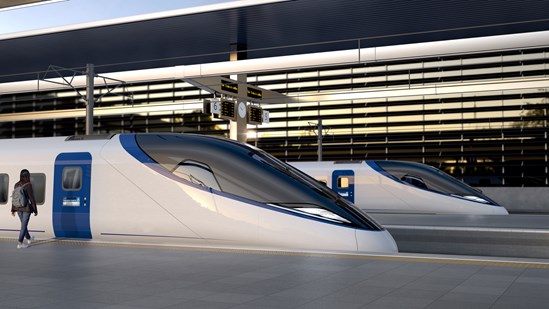High speed trains due to run on HS2 and further north on the West Coast Main Line will help deliver a “step-change in the passenger experience”, engineers said today, as detailed designs for the new fleet are finalised.
In the most extensive project of its kind seen in the UK, the public has been put at the heart of refining designs for the interior of the 54 trains. The process is being taken forward by West Coast Partnership Development (WCPD), HS2 Ltd and its manufacturing partner, joint venture Hitachi-Alstom High Speed (HAH-S).
Since the start of this year, a range of customer groups, including those with reduced mobility, cyclists and young families, have been invited to experience life-sized wooden mock-ups of the trains at the HAH-S facility in Derby – helping engineers to understand the levels of ease, accessibility and comfort.
The process included reviewing different options around boarding and alighting from the train, the positioning of grab rails to aid mobility and support, and testing the layout of toilets – particularly for wheelchair customers.
Life-sized mock-ups were also made of other sections of the train including, the café, and child buggy storage.
It forms part of a refinement process – supported by market research – that enables the final designs to be adjusted to fully meet the needs of passengers and staff. Although similar processes have previously been used in the development of rolling stock, this is believed to be the most extensive user development exercise ever undertaken for a new train fleet built in the UK.
Twenty groups have provided feedback on the designs so far as part of a process organised by WCPD, the train’s future operator. They also used insights from their ‘customer community’ – a consumer focus group of 5,000 people who have a mix of travelling needs. This underlines the scale of the progress that has already been made as part of the complex development of HS2’s fully electric trains that will offer unparalleled levels of reliability, speed and comfort and will help in the fight against climate change.
HS2 Ltd senior rolling stock engineer, James Dawson said:
“We’re designing HS2 to provide a step-change in the passenger experience so that it’s accessible to everyone – and especially to people who don’t currently think train travel is for them or don’t consider in the first place.
“I’m confident that work with both WCPD and HAH-S, plus our innovative design refinement approach, will deliver a quality product that stands the test of time.”
West Coast Partnership Development rolling stock director, Simon Aslett said:
“Together with our partners at HS2 and HAH-S, we want to produce a train that delivers the best travel experience in the UK and competes with other modes of transport. As part of our work to prepare for future operations, public testing at this stage of the programme enables us to make the right decisions for customers in this critical design phase of the project.”
Hitachi-Alstom High Speed collaborative design manager, Niall Simmons, said:
“As we progress towards delivering the next generation of high-speed trains for HS2, the feedback from passengers has been invaluable. Their insights are helping us refine the design to ensure that our trains not only meet but exceed expectations for accessibility, comfort and convenience. Engaging with a diverse range of future passengers, including those who may not typically consider train travel, has been crucial in shaping the features that will make a real difference to their experience.
“HAH-S is committed to putting passengers at the heart of every decision. By working closely with the public, we are confident that we’re creating a fleet of trains that will set new standards for intercity travel in the UK. This collaborative approach ensures that when HS2 is operational, it will deliver a transformative and stress-free journey for a wide range of people.”
Passengers like to be able to see their luggage throughout journeys, so designers have maximised both overhead and under seat storage space to accommodate a variety of baggage and case sizes in an effort to enhance convenience and reduce stress levels.
As part of the design, a carefully-considered mix of airline-style seats in rows and four table seats is provided throughout the train to ensure there is a seat for everyone’s needs and with generous legroom.
With feedback from user group sessions, designers have repositioned grab handles near the doors, created a ‘step-free’ solution at HS2 stations for passengers, rearranged USB-C sockets and tray tables, and adjusted wheelchair spaces to give a much better customer experience.
Future user group sessions will help designers to finalise passenger seat design to ensure they are comfortable for everyone on long journeys; as well as optimising the train’s LED lighting system to help deliver an enhanced ambience throughout the day and across the seasons.
Additionally, testers gave feedback on the ‘step-free’ access design that will enable passengers to board and alight more easily at HS2 stations.
Once the train’s designs are finalised, full production will start around 2027. Bodyshell welding and electrical installation will be led by Hitachi’s Co. Durham plant before the interior fit out is completed by Alstom in Derby.
HS2’s trains will offer direct services between London and the West Midlands plus services further north via the West Coast Main Line.
Manufacture of the rolling stock will take place in parallel to the huge construction of the new line, with the railway expected to be operational between 2029 and 2033. When complete, HS2 will create shorter and more reliable journeys, driving economic growth while crucially freeing up space on the southern part of the existing West Coast Main Line.
ENDS





